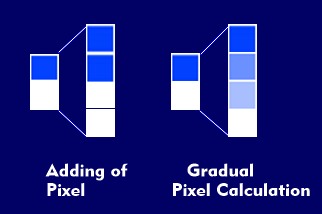scaling
Scaling is an adjustment of one size to another. It can be graphics that need to be resized, pixels that need to have their formats changed, computer power that is made available to certain applications, programs that adhere to a certain value system, or the adjustment of transmission capacity to meet the required demand.
Basic principles of digital video scalability Sc
alability of video data streams can be based on temporal, spatial and qualitative characteristics. For example, temporal scaling involves transmitting bit streams at a lower data rate or lower frame rate. Spatial scaling involves reducing the image size or lowering the resolution. In this case, the reduced content can be played back on the displays of smartphones, tablets or on televisions. It is different with qualitative scaling, where the temporal and spatial characteristics are preserved, but the fidelity, expressed in the signal-to- noise ratio, is reduced. The combination of the different techniques results in a wide variety of representations with temporal-spatial resolution.Scaling of digital video
When displaying digital video on flat screens and also when projecting with digitalprojectors, the pixel structure of the display does not necessarily correspond to that of the video signal. This is due to the fact that digital displays have square pixels, but the pixels of digital video can be rectangular in the various video formats. In addition, some image formats have to be adapted to the screen formats. When adjusting the resolution, one works with interpolation for the pixel formats with horizontal and vertical scaling. In scaling, the number of pixels of the image or video is converted to the nativescreen resolution of the display or projector. For example, if a digital photo with 800 x 600 pixels is to be displayed on a display with 1,920 x 1,080 pixels, then the individual pixels must be scaled vertically and horizontally. If scaled by a factor of 1.8, the image would be displayed correctly in height, but in width there would be black bars on the right and left edges of the screen. If it is scaled to fill the entire format, the image is distorted. Devices for scaling image formats are called scalers or scalers.- Scaling
in image processing
Intext and image processing, scaling is used to enlarge and reduce fonts, graphics and parts of drawings. Scaling can take place in one, two or, in the case of 3D graphics, in three coordinates. Likewise the scale conversion of a technical drawing is to be mentioned, with which the scaling can be made from the metric system in inch Scaling in transmission technology
In transmission technology, scaling is used for the flexible adaptation of transmission capacities to the required demand. This can equally be an increase in computing power or the dynamic allocation of transmission bandwidths and speeds. When allocating transmission capacities, scaling achieves a high degree of flexibility in adapting the transmission channels to the respective applications. The degree of utilization of the entire transmission link increases considerably compared to a fixed bandwidth allocation, which is not least noticeable in WAN applications in the form of a significant reduction in costs. Scalability is a key feature of ATM, since with ATM there is no clear definition of which physical transmission medium is to be used to transmit ATM cells at which transmission speeds. In addition, ATM networks can be expanded by new users without restricting the bandwidth available to the existing subscribers.


